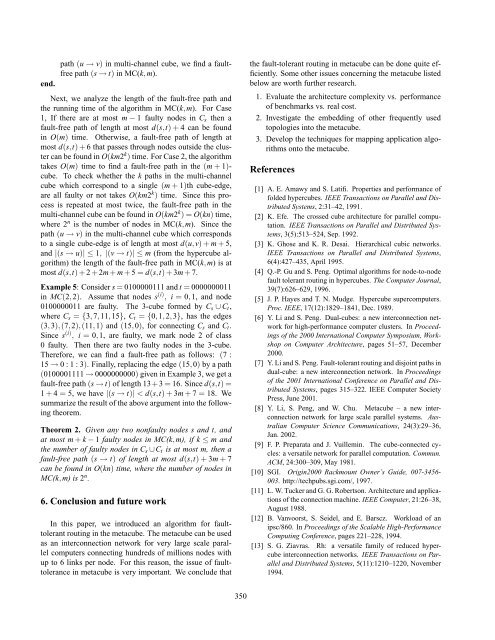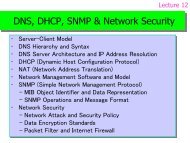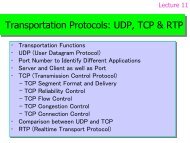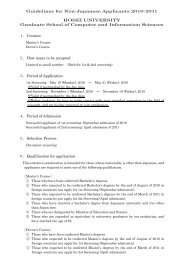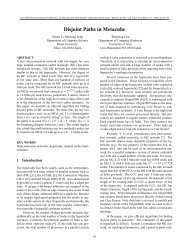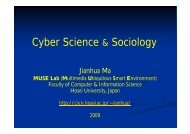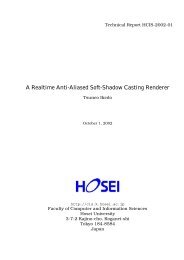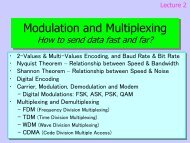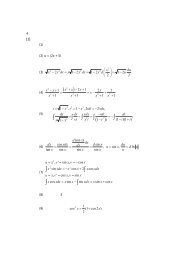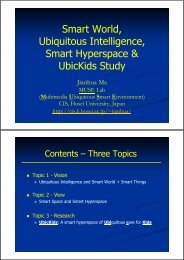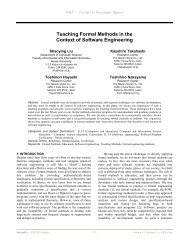Fault-tolerant Routing in Metacube - CiteSeerX
Fault-tolerant Routing in Metacube - CiteSeerX
Fault-tolerant Routing in Metacube - CiteSeerX
You also want an ePaper? Increase the reach of your titles
YUMPU automatically turns print PDFs into web optimized ePapers that Google loves.
end.path (u → v) <strong>in</strong> multi-channel cube, we f<strong>in</strong>d a faultfreepath (s → t) <strong>in</strong> MC(k,m).Next, we analyze the length of the fault-free path andthe runn<strong>in</strong>g time of the algorithm <strong>in</strong> MC(k,m). For Case1, If there are at most m − 1 faulty nodes <strong>in</strong> C s then afault-free path of length at most d(s,t) + 4 can be found<strong>in</strong> O(m) time. Otherwise, a fault-free path of length atmost d(s,t) + 6 that passes through nodes outside the clustercan be found <strong>in</strong> O(km2 k ) time. For Case 2, the algorithmtakes O(m) time to f<strong>in</strong>d a fault-free path <strong>in</strong> the (m + 1)-cube. To check whether the k paths <strong>in</strong> the multi-channelcube which correspond to a s<strong>in</strong>gle (m + 1)th cube-edge,are all faulty or not takes O(km2 k ) time. S<strong>in</strong>ce this processis repeated at most twice, the fault-free path <strong>in</strong> themulti-channel cube can be found <strong>in</strong> O(km2 k ) = O(kn) time,where 2 n is the number of nodes <strong>in</strong> MC(k,m). S<strong>in</strong>ce thepath (u → v) <strong>in</strong> the multi-channel cube which correspondsto a s<strong>in</strong>gle cube-edge is of length at most d(u,v) + m + 5,and |(s → u)| ≤ 1, |(v → t)| ≤ m (from the hypercube algorithm)the length of the fault-free path <strong>in</strong> MC(k,m) is atmost d(s,t) + 2 + 2m + m + 5 = d(s,t) + 3m + 7.Example 5: Consider s = 0100000111 and t = 0000000011<strong>in</strong> MC(2,2). Assume that nodes s (i) , i = 0,1, and node0100000011 are faulty. The 3-cube formed by C s ∪ C t ,where C s = {3,7,11,15}, C t = {0,1,2,3}, has the edges(3,3),(7,2),(11,1) and (15,0), for connect<strong>in</strong>g C s and C t .S<strong>in</strong>ce s (i) , i = 0,1, are faulty, we mark node 2 of class0 faulty. Then there are two faulty nodes <strong>in</strong> the 3-cube.Therefore, we can f<strong>in</strong>d a fault-free path as follows: (7 :15 → 0 : 1 : 3). F<strong>in</strong>ally, replac<strong>in</strong>g the edge (15,0) by a path(0100001111 → 0000000000) given <strong>in</strong> Example 3, we get afault-free path (s → t) of length 13+3 = 16. S<strong>in</strong>ce d(s,t) =1 + 4 = 5, we have |(s → t)| < d(s,t) + 3m + 7 = 18. Wesummarize the result of the above argument <strong>in</strong>to the follow<strong>in</strong>gtheorem.Theorem 2. Given any two nonfaulty nodes s and t, andat most m + k − 1 faulty nodes <strong>in</strong> MC(k,m), if k ≤ m andthe number of faulty nodes <strong>in</strong> C s ∪C t is at most m, then afault-free path (s → t) of length at most d(s,t) + 3m + 7can be found <strong>in</strong> O(kn) time, where the number of nodes <strong>in</strong>MC(k,m) is 2 n .6. Conclusion and future workIn this paper, we <strong>in</strong>troduced an algorithm for fault<strong>tolerant</strong>rout<strong>in</strong>g <strong>in</strong> the metacube. The metacube can be usedas an <strong>in</strong>terconnection network for very large scale parallelcomputers connect<strong>in</strong>g hundreds of millions nodes withup to 6 l<strong>in</strong>ks per node. For this reason, the issue of faulttolerance<strong>in</strong> metacube is very important. We conclude thatthe fault-<strong>tolerant</strong> rout<strong>in</strong>g <strong>in</strong> metacube can be done quite efficiently.Some other issues concern<strong>in</strong>g the metacube listedbelow are worth further research.1. Evaluate the architecture complexity vs. performanceof benchmarks vs. real cost.2. Investigate the embedd<strong>in</strong>g of other frequently usedtopologies <strong>in</strong>to the metacube.3. Develop the techniques for mapp<strong>in</strong>g application algorithmsonto the metacube.References[1] A. E. Amawy and S. Latifi. Properties and performance offolded hypercubes. IEEE Transactions on Parallel and DistributedSystems, 2:31–42, 1991.[2] K. Efe. The crossed cube architecture for parallel computation.IEEE Transactions on Parallel and Distributed Systems,3(5):513–524, Sep. 1992.[3] K. Ghose and K. R. Desai. Hierarchical cubic networks.IEEE Transactions on Parallel and Distributed Systems,6(4):427–435, April 1995.[4] Q.-P. Gu and S. Peng. Optimal algorithms for node-to-nodefault <strong>tolerant</strong> rout<strong>in</strong>g <strong>in</strong> hypercubes. The Computer Journal,39(7):626–629, 1996.[5] J. P. Hayes and T. N. Mudge. Hypercube supercomputers.Proc. IEEE, 17(12):1829–1841, Dec. 1989.[6] Y. Li and S. Peng. Dual-cubes: a new <strong>in</strong>terconnection networkfor high-performance computer clusters. In Proceed<strong>in</strong>gsof the 2000 International Computer Symposium, Workshopon Computer Architecture, pages 51–57, December2000.[7] Y. Li and S. Peng. <strong>Fault</strong>-<strong>tolerant</strong> rout<strong>in</strong>g and disjo<strong>in</strong>t paths <strong>in</strong>dual-cube: a new <strong>in</strong>terconnection network. In Proceed<strong>in</strong>gsof the 2001 International Conference on Parallel and DistributedSystems, pages 315–322. IEEE Computer SocietyPress, June 2001.[8] Y. Li, S. Peng, and W. Chu. <strong>Metacube</strong> – a new <strong>in</strong>terconnectionnetwork for large scale parallel systems. AustralianComputer Science Communications, 24(3):29–36,Jan. 2002.[9] F. P. Preparata and J. Vuillem<strong>in</strong>. The cube-connected cycles:a versatile network for parallel computation. Commun.ACM, 24:300–309, May 1981.[10] SGI. Orig<strong>in</strong>2000 Rackmount Owner’s Guide, 007-3456-003. http://techpubs.sgi.com/, 1997.[11] L. W. Tucker and G. G. Robertson. Architecture and applicationsof the connection mach<strong>in</strong>e. IEEE Computer, 21:26–38,August 1988.[12] B. Vanvoorst, S. Seidel, and E. Barscz. Workload of anipsc/860. In Proceed<strong>in</strong>gs of the Scalable High-PerformanceComput<strong>in</strong>g Conference, pages 221–228, 1994.[13] S. G. Ziavras. Rh: a versatile family of reduced hypercube<strong>in</strong>terconnection networks. IEEE Transactions on Paralleland Distributed Systems, 5(11):1210–1220, November1994.350


